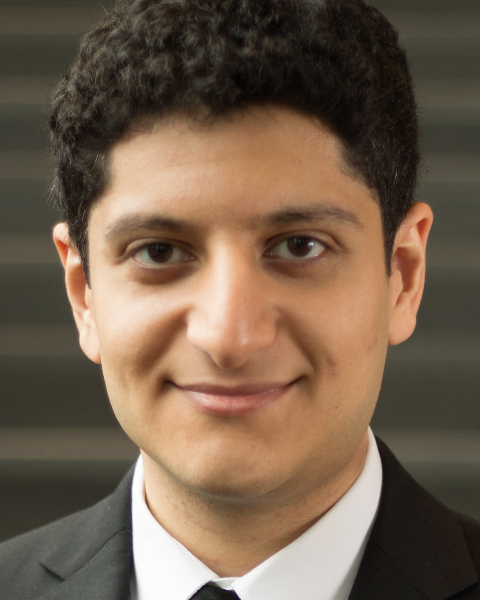PQA 01 - PQA 01 Lung Cancer/Thoracic Malignancies and Diversity, Equity and Inclusion in Healthcare Poster Q&A
2130 - Stereotactic Ablative Radiotherapy for Ultra-Central Lung Tumors: Local Control and Toxicity from a Seventeen-Year Single-Institution Experience
Sunday, September 29, 2024
2:45 PM - 4:15 PM ET
Location: Hall C
Screen: 17

Amir Safavi, MD, MSc
Memorial Sloan Kettering Cancer Center
New York, NY
Presenter(s)
A. H. Safavi1, A. T. Santiago2, C. Torres3, S. Raman3, B. H. Lok2, A. J. Hope3, A. Bezjak3, A. Y. Sun2,3, G. Wu3, J. P. Bissonnette3, B. C. J. Cho3, and M. E. Giuliani3; 1University of Toronto, Toronto, ON, Canada, 2Radiation Medicine Program, Princess Margaret Cancer Centre, University Health Network, Toronto, ON, Canada, 3Radiation Medicine Program, Princess Margaret Cancer Centre, Toronto, ON, Canada
Purpose/Objective(s): Stereotactic ablative radiotherapy (SABR) for ultra-central (UC) lung tumors can be associated with morbidity and mortality. We report local control (LC) and toxicity following SABR (=8 daily fractions) with planning target volumes (PTV) overlapping trachea, proximal bronchial tree (PBT), esophagus, and/or pulmonary artery and vein (PA/PV). Materials/
Methods: One hundred thirty-four of 1771 (7.6%) patients receiving lung SABR (January 2006-May 2023) were included from a prospective institutional database. In total, 141 UC lung tumors (75% primary NSCLC, 25% metastases, no nodes) were analyzed. Primary outcomes were LC and incidence of grade (G) 3-5 CTCAE V5.0 toxicity. Secondary outcomes were overall survival (OS), progression-free survival (PFS), regional (RC) and distant control (DC), and incidence of G2+ pneumonitis (RP).
Results: Median follow-up was 23.0 months (2.0-165.0). Median tumor size was 2.1 cm (0.8-6.0). Sixty-five (62.5%) patients with primary NSCLC were medically inoperable. PTV overlapped trachea in 7.1%, PBT 67.4%, esophagus 2.1%, PA 47.5%, and PV 12.8%. Tumor abutted PBT in 36.2% and PA/PV in 29.8%. No endobronchial invasion was noted. The most common prescription (89.4%) was 60 Gy in 8 fractions (BED10 59.5-123.6 Gy). Prescription isodose line (median: 87% [68.0-99.0]) was =90% for 96 tumors (68.1%). Median PTV D99 and D95 were 96.2% (38.1-99.2) and 100.0% (70.9-108.4). PTV D99=90% was achieved for 87.9% of tumors. PTV D95=100% was achieved for 66.7% of tumors. Median PTV average dose was 109.2% (100.2-125.0). PTV Dmax (median: 119.8% [104.8-149.2]) was =120% for 72 tumors (51.1%). Median Dmax,EQD2(a/b=3) (Gy) for trachea was 9.6 (0.1-138.5), PBT 124.6 (0.8-178.9), esophagus 22.2 (3.0-92.2), and PA/PV 135.6 (72.7-143.7). Median lung V20 was 8.8% (1.0-21.0). Five-year LC was 91.9% (95%CI:86.3-97.8). Tumor size (subdistribution hazard ratio (sHR)=1.50; 95%CI:1.01-2.23; p=.044), PTV volume (sHR=1.01; 95%CI:1.01-1.02; p<.001), and PET SUVmax (sHR=1.07; 95%CI:1.01-1.14; p=.021) predicted local failure. Two patients (1.5%) experienced G3-5 toxicities: 1) one with G3 pneumothorax/pneumopericardium, G3 RP, and G5 aspiration post 60 Gy in 8 fractions, 2) another with G5 heart failure exacerbation post 24 Gy in 1 fraction. Median OS was 46.0 months (95%CI:35.0-67.0). For patients with primary NSCLC, median PFS was 75.0 months (95%CI:35.0-NR) and 5-year RC and DC were 70.7% (95%CI:60.2-83.0) and 80.9% (95%CI:72.5-90.3). Incidence of G2+ RP was 12.9%. Multiple tumors (sHR=6.13; 95%CI:2.37-15.8; p<.001), lung V20 (sHR=1.12; 95%CI:1.01-1.23; p=.025), and systemic therapy use (sHR=5.70; 95%CI:1.88-17.3; p=.002) predicted G2+ RP.
Conclusion: SABR, planned over 8 fractions with limited organ-at-risk hotspots and moderate PTV Dmax, has high LC and low toxicity for well-selected patients with UC lung tumors.
Purpose/Objective(s): Stereotactic ablative radiotherapy (SABR) for ultra-central (UC) lung tumors can be associated with morbidity and mortality. We report local control (LC) and toxicity following SABR (=8 daily fractions) with planning target volumes (PTV) overlapping trachea, proximal bronchial tree (PBT), esophagus, and/or pulmonary artery and vein (PA/PV). Materials/
Methods: One hundred thirty-four of 1771 (7.6%) patients receiving lung SABR (January 2006-May 2023) were included from a prospective institutional database. In total, 141 UC lung tumors (75% primary NSCLC, 25% metastases, no nodes) were analyzed. Primary outcomes were LC and incidence of grade (G) 3-5 CTCAE V5.0 toxicity. Secondary outcomes were overall survival (OS), progression-free survival (PFS), regional (RC) and distant control (DC), and incidence of G2+ pneumonitis (RP).
Results: Median follow-up was 23.0 months (2.0-165.0). Median tumor size was 2.1 cm (0.8-6.0). Sixty-five (62.5%) patients with primary NSCLC were medically inoperable. PTV overlapped trachea in 7.1%, PBT 67.4%, esophagus 2.1%, PA 47.5%, and PV 12.8%. Tumor abutted PBT in 36.2% and PA/PV in 29.8%. No endobronchial invasion was noted. The most common prescription (89.4%) was 60 Gy in 8 fractions (BED10 59.5-123.6 Gy). Prescription isodose line (median: 87% [68.0-99.0]) was =90% for 96 tumors (68.1%). Median PTV D99 and D95 were 96.2% (38.1-99.2) and 100.0% (70.9-108.4). PTV D99=90% was achieved for 87.9% of tumors. PTV D95=100% was achieved for 66.7% of tumors. Median PTV average dose was 109.2% (100.2-125.0). PTV Dmax (median: 119.8% [104.8-149.2]) was =120% for 72 tumors (51.1%). Median Dmax,EQD2(a/b=3) (Gy) for trachea was 9.6 (0.1-138.5), PBT 124.6 (0.8-178.9), esophagus 22.2 (3.0-92.2), and PA/PV 135.6 (72.7-143.7). Median lung V20 was 8.8% (1.0-21.0). Five-year LC was 91.9% (95%CI:86.3-97.8). Tumor size (subdistribution hazard ratio (sHR)=1.50; 95%CI:1.01-2.23; p=.044), PTV volume (sHR=1.01; 95%CI:1.01-1.02; p<.001), and PET SUVmax (sHR=1.07; 95%CI:1.01-1.14; p=.021) predicted local failure. Two patients (1.5%) experienced G3-5 toxicities: 1) one with G3 pneumothorax/pneumopericardium, G3 RP, and G5 aspiration post 60 Gy in 8 fractions, 2) another with G5 heart failure exacerbation post 24 Gy in 1 fraction. Median OS was 46.0 months (95%CI:35.0-67.0). For patients with primary NSCLC, median PFS was 75.0 months (95%CI:35.0-NR) and 5-year RC and DC were 70.7% (95%CI:60.2-83.0) and 80.9% (95%CI:72.5-90.3). Incidence of G2+ RP was 12.9%. Multiple tumors (sHR=6.13; 95%CI:2.37-15.8; p<.001), lung V20 (sHR=1.12; 95%CI:1.01-1.23; p=.025), and systemic therapy use (sHR=5.70; 95%CI:1.88-17.3; p=.002) predicted G2+ RP.
Conclusion: SABR, planned over 8 fractions with limited organ-at-risk hotspots and moderate PTV Dmax, has high LC and low toxicity for well-selected patients with UC lung tumors.
